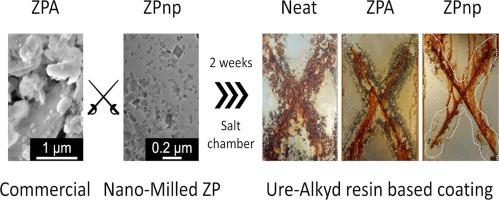释放磷酸锌纳米片在醇酸涂料配方中的潜力,在降低颜料含量的情况下提供先进的防腐保护
IF 6.3
2区 材料科学
Q2 CHEMISTRY, PHYSICAL
引用次数: 0
摘要
采用直接沉淀法和纳米铣削工艺制备了新型磷酸锌二维纳米薄片(ZPnp),有效地利用了层状前驱体优先破碎成薄片的特性。XRD分析鉴定出晶态为希望石(Zn3(PO4)2·4H2O), SEM/TEM显示出横向尺寸小于100 nm的矩形片状颗粒。DLS可以实现铣削过程的跟踪,BET可以确定ZPnp的纳米级特性。将1.6 wt.%的纳米ZPnp浆料(40 wt.%的固体)加入到混合聚氨酯-醇酸(UreAlkyd)面漆中,与含有4 wt.%铝处理的磷酸锌(ZPA)微粉的面漆进行了屏障(被动)和主动愈合性能的比较。采用EIS法对涂层的性能进行了评价,并通过标准盐雾试验直接进行了比较。采用原子吸收光谱法测定不同pH值盐水溶液中的离子释放量。研究发现,长期暴露于ZPnp中,ZPnp形成的抑制层更致密,而商业ZPA在初始浸泡时间的活性位点阻断效果相对较好。与含zpa的商业样品相比,含zpnp的配方在人工划伤和完整涂层中都表现出更高的耐腐蚀性,以及更低的电容。因此,一种优越的活性/屏障式防腐保护系统的开发得到了证明,该系统在防腐色素含量降低6倍以上的情况下具有延长的愈合活性。本文章由计算机程序翻译,如有差异,请以英文原文为准。

Unlocking the potential of zinc phosphate nanoplatelets for alkyd coating formulation with advanced anti-corrosive protection at reduced pigment content
Novel zinc phosphate 2D nanoplatelets (ZPnp) were prepared by direct precipitation followed by a nano-milling process, effectively utilizing the preferential fragmentation of the lamellar precursor into thin platelets. The XRD analysis identified hopeite (Zn3(PO4)2·4H2O) as the crystalline phase, while SEM/TEM revealed rectangular, plate-like particles with lateral dimensions below 100 nm. DLS enabled tracking of the milling process, and BET was used to confirm the nanoscale character of ZPnp. The effect of incorporating 1.6 wt.% nano-milled ZPnp slurry (40 wt.% solids) into a mixed urethane–alkyd (UreAlkyd) topcoat on barrier (passive) and active-healing performance was compared with that of a coating containing 4 wt.% commercial Al-treated zinc phosphate (ZPA) micropowder. The performance of the coatings was assessed using EIS and directly compared through standard salt-spray testing. Ion release was quantified by AAS in saline solutions at different pH values. It was found that the more compact/denser inhibitive layer formation observed in long-term exposures for ZPnp prevails over the relatively better active-site-blocking effect of the commercial ZPA at initial immersion times. The ZPnp-containing formulation exhibited higher corrosion resistance, along with lower capacitance, in both artificially scratched and intact coatings compared to the commercial ZPA-containing sample. Hence, the development of a superior active/barrier anti-corrosion protection system that possesses prolonged healing activity at more than six times lower anti-corrosion pigment content was demonstrated.
求助全文
通过发布文献求助,成功后即可免费获取论文全文。
去求助
来源期刊

Surfaces and Interfaces
Chemistry-General Chemistry
CiteScore
8.50
自引率
6.50%
发文量
753
审稿时长
35 days
期刊介绍:
The aim of the journal is to provide a respectful outlet for ''sound science'' papers in all research areas on surfaces and interfaces. We define sound science papers as papers that describe new and well-executed research, but that do not necessarily provide brand new insights or are merely a description of research results.
Surfaces and Interfaces publishes research papers in all fields of surface science which may not always find the right home on first submission to our Elsevier sister journals (Applied Surface, Surface and Coatings Technology, Thin Solid Films)
 求助内容:
求助内容: 应助结果提醒方式:
应助结果提醒方式:


